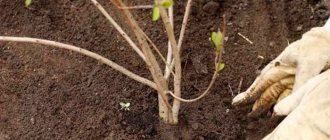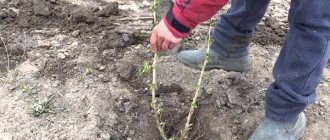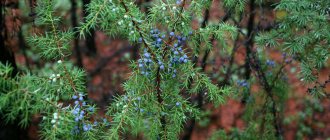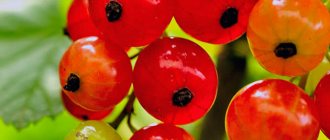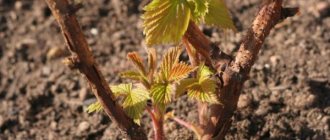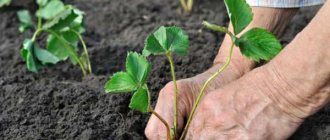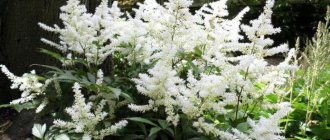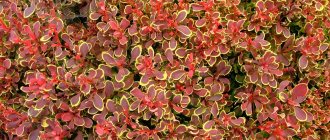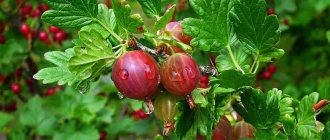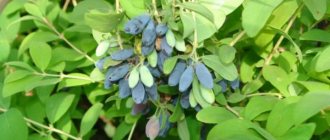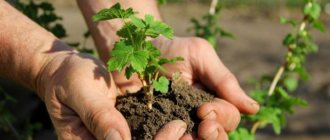Why transplant honeysuckle to a new place in the fall and is it possible to do it?
Honeysuckle grows in one place and bears fruit for up to 25-30 years. Frequent replanting of the shrub is not required - this does not affect its productivity, growth and development.
Reasons for transplantation:
- the bush has grown too much to the sides;
- the bush displaces neighboring plants;
- redevelopment of the territory;
- The wrong location was initially chosen.
Honeysuckle is prone to early vegetation; the first warm temperatures in spring lead to bud growth and flowering of the plant. Therefore, it is difficult to replant it in the spring.
In the case of spring transplantation, the shrub will require more careful care (ample watering, loosening and fertilizing) and will take root with difficulty.
In autumn, honeysuckle enters a dormant stage and prepares for winter. This is the most suitable time for transplantation.
Timing of seasonal transplantation of honeysuckle
Honeysuckle is one of the plants that begin to become active during any warming: the slightest thaw provokes bud growth. If, after a thaw, short-term frosts occur again, it stops the development phase only for a while, and then continues to grow with renewed vigor.
In spring, a plant can sprout up to 7 times, depending on weather conditions, so transplanting a seedling at this time has many nuances.
Spring
It is believed that transplanting a seedling in the spring is still possible. This can be done during a period when there is no rapid growth of shoots, that is, in March or early April. May and June are the period when the plant is most likely to be injured and dry out during transplantation. It is very important to replant honeysuckle while maintaining a large lump of earth on the root system: this procedure will cause less stress for the plant.
Did you know? Today there are approximately 250 species of honeysuckle in the world, most of which are inedible. It is quite simple to distinguish poisonous varieties from edible ones: the former have bright red or orange berries, and the latter
—
blue and black.
Autumn
It is most convenient to replant overgrown honeysuckle in the fall, when it has entered the dormant stage. Transplantation can be carried out starting in September. The main thing is not to wait until the soil begins to freeze, so the deadline for manipulating honeysuckle should be mid-October (in some regions - early November).
Where to transplant
Choose a place for planting that is illuminated. It is important to consider the direction of the sun's rays during the day. Honeysuckle produces maximum yield when its upper branches are in the sun and its lower branches are in the shade.
To prevent gusts of wind from breaking the fragile branches of the bush, it is transplanted not to hillocks, but to lowlands. They avoid drafts - the bush does not like them. However, the transplant site must be ventilated.
If several bushes are transplanted, a distance of 1.5 m is maintained between them.
Selection of planting material
It is worth remembering that honeysuckle also has decorative inedible species.
There are decorative and edible varieties of honeysuckle, so seedlings are purchased with specific purposes in mind. To avoid over-grading, you should buy planting material in specialized stores or nurseries.
The main criteria for a quality seedling:
- age 2–3 years;
- strong trunk and 2–4 side shoots without signs of damage;
- healthy, dense kidneys;
- fresh, clean, well-developed leaves;
- strong, flexible, well-developed roots.
Preparing honeysuckle
Dry and damaged branches on the bush are pruned and the shoots are shortened. The optimal height of the bush is up to 0.5 m . Damaged and dry branches are cut off from young bushes; shoots are not shortened.
The soil around the bush is watered. The bush is carefully dug up so as not to damage the roots. To make adaptation faster, honeysuckle is replanted along with the soil. They begin to dig along the perimeter of the crown, since the root system grows to the length of the branches.
The ditch is deepened at an angle to form a cone. Any roots that come across are cut with a shovel. The bush is taken out, placed on film, wrapped and transferred to the transplant site.
Soil preparation
Honeysuckle grows well in any soil. But you should not replant it in places with close groundwater: excess moisture negatively affects the growth of the plant and leads to rotting of the root system.
The best option for replanting is loamy and sandy loam soils with a neutral acidity level . High acidity is reduced by liming. When digging, add dolomite flour (0.2-0.4 kg per 1 m²).
Before transplanting, holes are made in the soil. The excavated soil is fertilized with ash (1 l), compost (1 bucket) and superphosphate (100 g).
Necessary measures for good yield
The fruiting process is influenced not only by the period when honeysuckle is replanted, but also by caring for the plant. The gardener's attention should be directed to:
- Watering the bush . The plant does not like dry soil, but is also sensitive to waterlogging. It is especially important to water correctly during the berry-filling period. In dry summers, water the plant at the root, adding 2 buckets of water under each bush. After watering, you should carefully loosen the soil surface, remembering that honeysuckle has a shallow root system. Weeding can simply injure it, and this adversely affects the development of the green creature.
- Timely pruning . The plant branches quickly and needs rejuvenation. The first pruning is carried out in the 5th year of life. And earlier, if necessary, they carry out sanitary measures, removing damaged and dry lashes.
- Adding nutrients . Honeysuckle loves organic matter. It is applied 2 times a year. Also, do not forget about the use of mineral complexes. In the spring, nitrogen compounds are applied, in the fall - potassium and phosphorus fertilizers.
- Replanting a plant in the case of an illiterate choice of place for growing the crop.
As a rule, honeysuckle tolerates transplantation well at any age. But the older it is, the more problematic it becomes to carry out gardening work and move the plant to a new place. That is why you should determine the best place for growing tasty berries as early as possible and carry out only measures to care for the crop. Also read our article “Why honeysuckle does not bear fruit.”
How to properly transplant honeysuckle to a new place
Most often, honeysuckle is transplanted into holes, but if there are a large number of bushes, the trench planting method is used.
Trench method
The trench method is often used when planting new seedlings. It is also used when transplanting several bushes.
Before replanting, dig a trench 0.5 m wide and 0.3 m deep. A drainage layer of pebbles or broken bricks is laid at the bottom of the trench. Add compost or humus (1 bucket), superphosphate (100 g), wood ash (1 l) to the dug soil.
Transfer the dug bush with a lump of earth and place it vertically in the trench. The roots are straightened and sprinkled with earth on top. Bushes should be planted at a distance of at least 1.5 m.
The planted bushes are watered. The soil is mulched with hay, sawdust or peat to protect plants from frost and retain moisture in the soil.
Pit method
7 days before transplantation, a 1x1 m hole is prepared. A drainage layer of fragments of brick, pebbles or crushed stone is laid on the bottom. A mixture is prepared from the excavated soil. Add a bucket of compost, 1 liter of ash, 100 g of superphosphate to it. Then 2/3 of the fertilized soil is poured into the hole. 2 buckets of water are poured on top.
After the soil has settled, make a hole. Since the roots of the shrub lie shallow, its depth is no more than 0.5 m. The dug out bush is placed in a recess so that the root collar is level with the ground surface. Straighten the roots and sprinkle with the remaining fertilized soil. The transplanted bush is watered.
Then the soil is mulched with leaves, sawdust or peat. This provides protection for the root system in cold weather.
Useful tips
In order to efficiently plant honeysuckle, you must adhere to certain rules - this will ensure good survival rate and intensive development of roots and crown. Recommendations from experienced farmers will help you carry out all the necessary work correctly:
- Experienced gardeners advise starting replanting when the shoots of the plant turn brown, which means that it is fully ripe;
- to make it easier to remove the bush from the ground for replanting, you can use any object as a jack, placing it under the earthen lump - this way it will remain monolithic and will not be damaged;
- the lump must be formed using a shovel in the form of a cone pointing downward;
- it is important to maintain in the new location the same direction of the bush branches in relation to the cardinal points as it was in the old area;
- You cannot prune honeysuckle that has already been transplanted - you can only remove shoots injured during transportation;
- mature bushes can be replanted from the second half of September to mid-November;
- We must not forget to maintain a distance of one and a half meters or more between transplanted and neighboring plants;
- As for spring planting, honeysuckle cannot be transported in this case; it can only be handled with a large ball of earth (unfortunately, such plants often get sick and develop poorly due to the early appearance of buds).
Sometimes the reason that the growth and fruiting of a crop is delayed is an undesirable neighborhood. And due to the fact that honeysuckle has just begun to become widespread in the gardens of the middle zone, not everyone knows how well honeysuckle is compatible with apple, quince, pear, cherry, gooseberry, plum and black currant. These crops do not suppress the vital activity of the plant when they release active biological components into the soil.
Fortunately, honeysuckle does not need to be replanted often; the plant can produce excellent harvests for decades. And with the right approach, you can replant even old bushes without harming their viability and fruiting.
To learn how and when to replant honeysuckle, see the following video.
Care after transplant
It is important to control soil moisture. If the weather is dry and warm after transplantation, then the bush is watered once a week. Watering rate is 1.5 buckets of water per bush.
Edible honeysuckle is not afraid of cold weather. It can withstand frosts down to −45°C, so it is not covered for the winter. To prevent branches from breaking off due to heavy snow, they are tied into bundles and bent to the ground.
Decorative honeysuckle is less frost-resistant. But it is covered and mulched only in the first years after planting. The climbing stems of the young plant are removed from the supports, carefully bent to the ground and covered with spruce branches.
In the spring, standard care begins for the crop, which consists of fertilizing, watering, loosening, pruning and treatment for diseases and pests.
Top dressing
In the spring, before the buds open, the bush is fertilized with ammonium nitrate. In dry form, it is applied to the soil under each bush, 15 g per 1 m². Or water with urea solution - 1 tbsp. l. for 10 liters of water.
In the fall, after the end of the fruiting period, the soil under the bush is fertilized with a solution of nitrophoska or nitroammophoska - 25 g per 10 liters of water. Organic fertilizers are applied for 3-4 years (10 liters per 1 bush).
Watering
Water the plant moderately. The norm is 1.5 buckets for one bush.
During the dry period, it is watered abundantly, the norm is increased to 2.5 buckets.
Lack of moisture causes the berries to grow bitter.
Loosening
The soil is loosened shallowly (7-8 cm), because the roots of the bush lie in the top layer of soil.
If the ground under the bush is mulched, it does not need to be loosened.
Trimming
In the spring, sanitary pruning is carried out - old, diseased, broken branches are cut from the bushes.
Formative pruning is carried out from the fourth year. The bush is given a spherical shape. In the central part, thick shoots are cut to the point of lateral growth. Branches growing inward and spreading along the ground are removed.
Anti-aging pruning is carried out on bushes older than 8 years to prolong the life of the bush. Remove old branches and some trunks.
Once every 3-4 years, detailed pruning is carried out to increase fertility: damaged and non-viable shoots are removed.
Disease and pest control
Resistance to diseases and pests of honeysuckle is average. The shrub is affected by viral and fungal diseases:
- Powdery mildew occurs when there is insufficient or improper watering. The leaves become covered with white powdery spots. Moderate watering is important for prevention. When signs of disease appear, the bush is sprayed with a solution of Myclobutanil (30 g per 10 liters of water).
- Cercospora blight is a fungal disease in which brown spots with a red edge appear on the leaves. The leaves then dry out and die. The affected parts of the plant are cut off and burned, the bush is treated with a 3% solution of Bordeaux mixture.
- Ramularia - in spring, grayish-white spots appear on the leaves, which gradually increase in size and darken. The disease affects the stems and stalks of honeysuckle. In case of damage, the bush is sprayed with “Fundazol” (10 g per 5 liters of water). Or use a solution of wood ash (100 g per 1 bucket of water) - water the root zone and spray the plant.
- Leaf mottling - dark red or brown spots appear on the leaves. The leaves turn yellow and fall off. To combat the disease, the affected leaves are cleaned and burned. If the disease is advanced, the plant is disposed of.
This is interesting:
Why does powdery mildew appear on cucumbers and why is it dangerous?
How to treat beet cercospora and prevent the occurrence of this disease.
Diseases and pests of parsley: photos, methods of control and prevention.
The main pests of shrubs:
- Honeysuckle mite - sucks the juice from the leaves, as a result the leaves wither and curl. To combat insects, the plant is sprayed with a solution of Actellica (7 ml per 10 liters of water) or Confidora (1 g per 10 liters of water).
- Honeysuckle aphid - sucks juice from shoots. To combat, use “Aktellik” (7 ml per 10 liters of water) or “Confidor” (1 g per 10 liters of water).
- Scale insect - sticks to the bark and sucks the juice from the branches. To get rid of the insect, the plant is sprayed with Actellika solution (7 ml per 10 liters of water), and the root zone is watered with Rogor-S solution (6 liters per hundred square meters of land).
How to divide a mature honeysuckle bush. Propagation of honeysuckle by cuttings and dividing the bush
Honeysuckle berries are one of the earliest, have a pleasant sweet and sour taste, ripen quickly and delight gardeners with their first delicious harvest. To increase the number of bushes in the garden or update old ones, you can grow new bushes yourself.
cuttings - the easiest way, which does not require special skills and abilities. In addition, honeysuckle is propagated by dividing the bush, cuttings or seeds.
When and how to propagate by cuttings
For green cuttings, annual strong shoots are cut. You need to cut with a sharp knife or blade; pruners and scissors are not suitable, as they deform the cut site. Then the cut shoots must be divided into small sections 15 cm long. An important condition is that at least 3-4 pairs of green leaves must remain on each prepared cutting. The most important thing: propagation of honeysuckle by cuttings is carried out with the appearance of ripe berries. At this point, shoot growth stops (mid or late June).
To ensure that the prepared shoots take root well, the leaves are cut off from them, leaving only one pair at the top of the cutting. The lower cut is shortened to the first bud. The cuttings prepared in this way are planted in moist soil under a film or in a greenhouse. For rapid growth of the root system, planting is done at an angle, deepening it by 1.5-2 cm. Before planting in the ground, the lower cut can be dipped in a growth stimulator. The soil should be light, capable of good air and water permeability. To do this, take peat and sand in a ratio of 1:2. The soil is watered and slightly compacted.
Optimal growing conditions
To speed up the process of root formation, propagation of honeysuckle by cuttings is carried out in warm weather. In the first days after planting the cuttings, the temperature should be at least 25 degrees. For this reason, young seedlings are placed under cover or in a greenhouse. Water once a week, in hot weather - every 4-5 days.
If everything is done correctly, the first roots will appear within 2 weeks. Then the growth of the root system will be very active. By the end of summer, the seedlings will already be strong and ready to be transplanted to the growing site. In about two years you will receive new full-fledged bushes and will be able to renew your honeysuckle. Planting in spring in a permanent place is carried out after the snow melts and the establishment of above-zero night temperatures.
Reproduction by dividing the bush
If propagating honeysuckle by cuttings seems too slow, since you will have to wait 3 years for berries, then you can divide the bush. To do this, you will need a young, not too overgrown honeysuckle bush. It is dug up, the roots are carefully cleaned and divided into several parts. To divide, you will need a well-sharpened knife. The cut areas are sprinkled with ash and the bushes are planted in the prepared holes. Planting should be done in fertile soil. You can add well-rotted humus or compost to the soil. You cannot use fresh manure, as there is a high probability of root rot and death of the bush. This entire operation is carried out before the buds begin to bloom or in the fall. Reproduction in the spring is a more advantageous option, since over the summer the honeysuckle will take root well and will be ready for further wintering.
The nuances of transplantation depending on the growing region
The timing of transplanting honeysuckle to a new location in the fall depends on the climatic conditions of the region. In central Russia and the Moscow region it is held in mid-October. Honeysuckle is highly frost-resistant, but does not tolerate sudden warming in winter. Such weather conditions are typical for central Russia, so gardeners in these regions should take care of covering the shrubs for the winter.
In the northern regions, they are replanted in early September so that the shrub has time to take root before winter and can survive severe frosts.
In the southern regions, the procedure is carried out in late October - early November. In hot and dry weather, transplanted honeysuckle does not take root well - it is important to periodically water it and loosen it.
When to plant honeysuckle: autumn or spring
When choosing the period for planting honeysuckle, it is advisable to find time in the fall. The culture is unpretentious, seedlings with a good earthen ball take root in the spring, but at this time there is a high risk of miscalculating the timing. The plant begins to flow sap early, and if you do not have time before the buds open, the honeysuckle will wither.
It is most convenient to plant in September or October, taking into account the weather and climate of a particular area.
Step-by-step instructions for planting honeysuckle in spring
The site has been prepared since the fall:
- They dig up the bed and level the soil.
- In the spring, after the snow melts, they dig holes 40x40 cm wide and pour crushed stone on the bottom.
- The top layer of soil is mixed with 2 buckets of humus, 30 g of superphosphate and the same amount of fertilizer containing potassium. Potassium fertilizer can be replaced with ash (500 g). In sandy areas, add another bucket of humus, and add a bucket of sand to clay soil.
- Excessively acidic soil is alkalized with dolomite flour or lime - 100 g per pit.
The composition of the soil can be improved by applying AVA fertilizer (15 g/m2) - a concentrated complex of minerals and microelements. The fertilizer dissolves in the ground slowly, saturating the plants with nutrients over the course of 2–3 years. As a result, seedlings quickly gain strength and adapt more easily to the new environment.
Complex fertilizer AVA slowly dissolves in the soil, saturating plants with nutrients
Instead of mineral fertilizer, vermicompost is often used, which improves and reclaims the soil. Add 1.5 kg of dry fertilizer or 3 liters of solution to the hole and mix with the soil.
Before planting, the roots of the seedlings are immersed in water with the addition of a growth stimulator for several hours.
- Fertilized soil is poured into the planting hole in a mound.
- Place the bush in the center, spreading out the roots. Container plants are transferred along with the earthen ball.
The honeysuckle seedling is placed in the center of the hole
- Cover the plant with soil (the root collar should be 5 cm below ground level), compacting the soil around it.
- Form a hole around the seedling and add a bucket of water into it.
- Mulch the root zone with straw or hay in a 10 cm layer.
Honeysuckle bushes, unlike other berry crops, are not shortened after planting so as not to cause a delay in their growth and development.
In the first days, young bushes must be shaded from bright sunlight and the soil must be regularly moistened, adding at least 10 liters of water under the plant.
How to prepare for landing
Future yields and longevity of the shrub depend on the quality of planting material, proper placement on the site and further care.
Selection of seedlings
Varietal honeysuckle seedlings can be purchased at nurseries. Usually they offer plants in pots, which are necessarily equipped with a certificate indicating the variety, age, and brief recommendations for growing. It is preferable to choose two-year-old bushes about 40 cm in height, with 2-3 flexible branches. You should not purchase low-growing weakened plants or too tall ones, more than one and a half meters, which take root painfully and later bear fruit.
It is best to purchase two-year-old honeysuckle seedlings with a closed root system - there is less risk that the plant will not take root due to root damage
How to store seedlings before planting
If seedlings are purchased after the onset of autumn cold weather, they should be properly stored until spring planting. The remaining leaves need to be torn off - they speed up the drying of the plants.
- In a garden in an elevated place, where melt water does not accumulate and snow does not blow away in winter, make a trench with one sloping side and place plants in it with their tops facing south.
- The seedlings are watered, the roots and branches are covered 1/3 of the length with loose soil.
- After the night temperature drops to minus values, the trench is completely covered with soil and compacted so that cold air does not penetrate to the plants. If snow covers seedlings without an earthen mound, during a thaw it will turn into an ice crust that can damage the plant bark.
- Prickly spruce branches are placed on top to protect the seedlings from rodents.
Until spring, honeysuckle seedlings can be buried in the garden, covering them on top with prickly spruce branches or juniper branches
To prevent the snow on buried seedlings from melting during a thaw, experienced gardeners cover the snowdrift on the buried seedlings with sawdust with a layer of at least 10 cm.
Video: autumn digging of seedlings
Honeysuckle bushes are well preserved in a cool room at temperatures from 0 to +2 °C.
- The purchased seedlings are removed from the packaging and examined carefully. There should be no mold or rot on the roots.
- The earthen lump must be solid. If it is dry, it is moistened.
- Then they wrap the root system with plastic film with holes for ventilation and place the seedling in the basement, refrigerator or on a closed loggia, or simply sprinkle the roots up to the root collar with wet sawdust.
The roots of honeysuckle seedlings are wrapped in plastic film with holes for ventilation and the plants are placed in the basement.
- Once every 10 days, check the plants, monitor the humidity of the earthen ball, and water if necessary.
- Maintain a temperature of up to +5 °C: at higher temperatures, the kidneys may begin to awaken. To lower the temperature, open doors and vents for a while.
If in the middle of winter buds larger than 2 cm appear on the honeysuckle, it means that it has woken up and the growing season has begun. It urgently needs to be planted, but since it is still cold outside, the plant is transferred to a larger pot.
- Remove the packaging and inspect the root system to see if there are new white roots.
- If they have not yet sprouted, the earthen ball is dipped into a solution of Kornevin or Heteroauxin for several hours.
- Then the seedling is planted in a container, filling the voids with a new substrate, and watered well.
- The pot with honeysuckle is placed in a cool, bright room, shaded from direct sunlight.
Place the pot with honeysuckle in a bright room, water it and monitor the temperature
Transferring into a new container should be done very carefully, trying to keep the earthen ball intact so as not to injure the young roots.
It is necessary to regularly moisten the soil and maintain a temperature of +5–12 °C - in a hot room the plant will begin to develop intensively. As soon as the snow melts, honeysuckle can be transplanted into the garden.
Video: storing seedlings in the basement
Choosing a landing site
Before planting bushes on the site, you should decide on the choice of location. Honeysuckle loves to grow in the sun; in the shade, productivity drops significantly and the berries lose their sweetness. Resistance to unfavorable conditions allows the shrub to be grown in open areas not protected from the wind by a fence or outbuildings - there it grows better, blooms and bears fruit more abundantly.
In an open sunny area, honeysuckle will bear fruit more abundantly
Honeysuckle is an unpretentious crop, but it feels most comfortable on fertile sandy or loamy soil with a low acidity level. In areas with acidic soil, plants wither, the color of the foliage fades, and there are significantly fewer berries. Swampy lowlands with close groundwater are also not suitable for berry gardens - water layers should lie no higher than 1.5 m from the surface of the earth.
The best predecessors of honeysuckle are potatoes, cucumbers, and radishes. It gets along well next to berry bushes such as dogwood, black currant, and barberry.
Recent Entries
5 working ways to use tar in the garden 7 indoor plants that help you get married even in adulthood Indoor plants that can bloom in trouble
For the formation of fruit ovaries, a cross-pollinated crop requires other varieties of edible honeysuckle, which are planted at a distance of 1.5 m from each other, leaving 2 m between rows. Shrubs that are too close, growing over time, will cast a shadow on each other. In addition, in narrow passages between overgrown bushes when picking berries, fragile shoots can easily be broken.
Enough space should be left between the bushes so that, as they grow, they do not interfere with each other and are evenly illuminated by the sun.
Berry bushes can be planted in a group or placed in a row along the edge of the site as a hedge. Honeysuckle is also used for zoning the garden, to delimit and decorate the territory.
